According to a report by MarketsandMarkets, the voice recognition software market size was $9.4 billion in 2022. The market is expected to grow to $28 billion by 2027.
What’s driving this rapid growth?
In the end, it’s a matter of simplicity. Laziness breeds invention, and this is more relevant than ever in healthcare, where convenience, time-saving and practicality cannot come soon enough.
In this article, we’ll walk you through the leading names in medical dictation software. You’ll learn about their key features, advantages, and drawbacks, and we’ll compare pricing to help you decide which option fits your practice best. Or whether you even need one at all.
Learn how to simplify your practice workflow and free up more time for patients with Medesk.
Open the detailed description >>What Is Medical Dictation Software?
Medical dictation software, also known as medical transcription software, converts spoken words into written text to help healthcare professionals create notes, reports, and patient records more efficiently. Instead of typing, you simply talk into a microphone or mobile device while the software quickly transcribes your words through voice recognition technology.
Modern dictation tools can recognise medical terms and even learn to understand your accent or speaking style over time. This software typically includes features such as speech recognition, text editing, AI integration, template creation, and integration with EHR systems.
Do I Need Medical Dictation Software?
Numerous medical professionals rely on this type of software to expedite the process when it comes to patient visits, dictating medical notes and keeping accurate records without having to spend additional time typing.
Here’s who tends to benefit from medical dictation software:
- Doctors and physicians. They use it to record notes and reports quickly, saving time compared to manual typing. A nice bonus is that most reports can be exported to formats like CSV, Excel, or even interactive online PDF.
- Hospitals and clinics. These facilities rely on it to streamline high volumes of medical documentation.
- Medical transcriptionists. They use the software to transcribe audio dictated by medical professionals into accurate written text.
If you fit into one of these categories, perhaps the best dictation software and apps we tested will help you find the right solution for your needs. To get us started, here’s a quick comparison table:
Top 5 Medical Dictation Software in 2025
| Software | Key Features | Pricing |
|---|---|---|
| Dragon Medical One | Cloud-based, PowerMic Mobile support, custom commands/templates, hands-free operation | $99/month (1-year license) + $525 implementation fee |
| Deepgram | AI-powered transcription, medical-grade accuracy, speaker identification, multi-language support | Free $200 credits for trial; Growth Plan $4,000–$10,000/year; Enterprise custom pricing |
| DeepScribe | Real-time speech recognition, automatic EHR integration, specialty-specific templates, AI coding support, pre-charting | Variable; contact sales for pricing |
| Amazon Transcribe Medical | Medical-accurate transcription, specialty customization, real-time & batch processing, API access | Pay-as-you-go; free tier 60 min/month; contact AWS for quote |
| WebChartMD | Flexible dictation, document review and e-signature, API integration | Free trial with $500 credit; pricing tailored by practice size & features |
#1. Dragon Medical One: Cloud-Based Dictation for Healthcare Professionals
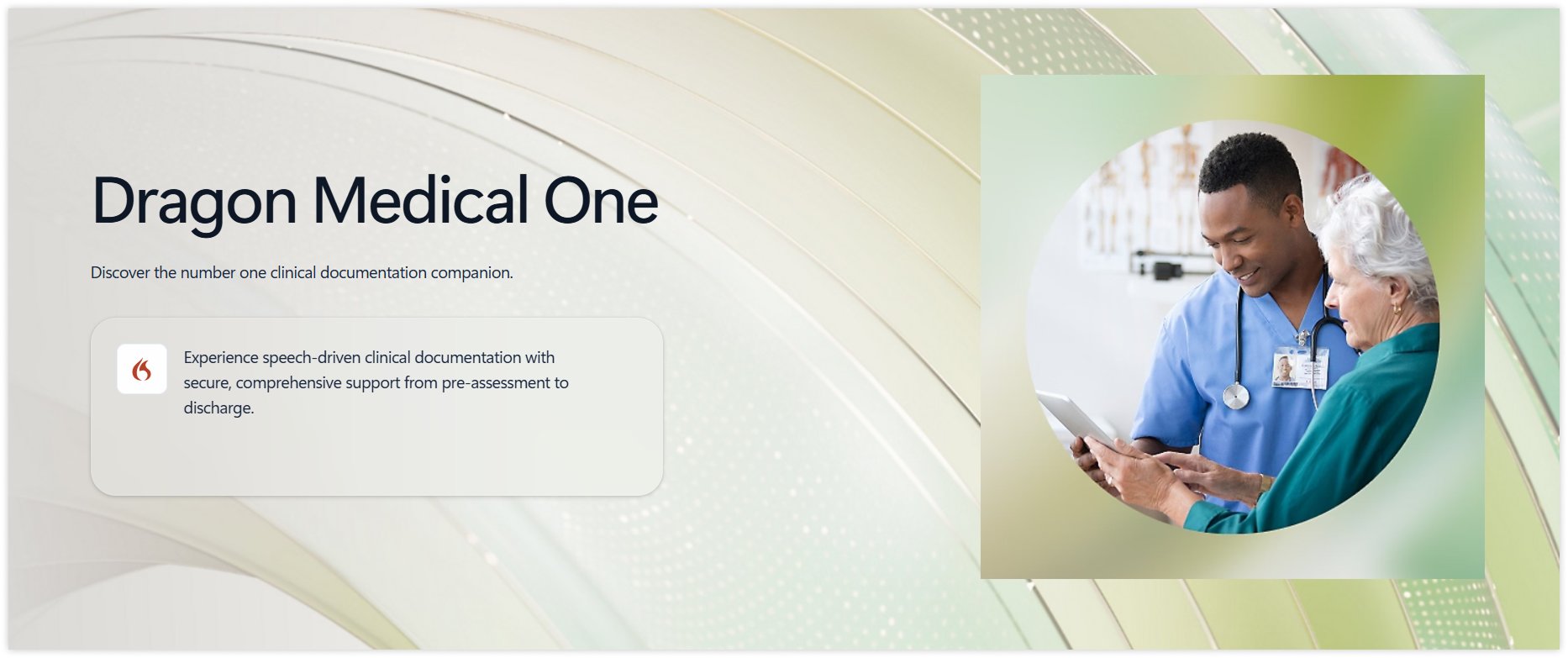
Dragon Medical One by Nuance (now part of Microsoft) is a cloud-based speech recognition platform designed specifically for healthcare professionals. It allows you to dictate notes directly into most EMR systems.
Unlike traditional desktop dictation solutions, Dragon Medical One is cloud-based. This means your profile, preferences and custom vocabulary come along with you wherever you’re working.
Key Features
PowerMic Mobile support. Turn your smartphone into a wireless microphone. This feature is ideal for clinicians on the move and for telehealth purposes.
Auto-formatting and smart punctuation. Automatically applies punctuation and formatting for clear, polished note-taking.
Custom commands and templates. Use it to build and share voice shortcuts or templates for everyday phrases, reports, or workflows.
Hands-free operation. Use simple voice commands like “wake up” or “go to next field” to navigate and dictate without touching your keyboard.
HIPAA-compliant cloud security. All information is encrypted and stored in Microsoft Azure. That’s another way of saying your patients’ information is safe and sound.
Pros
- Very accurate and adaptive speech recognition.
- Integrates with many top EHR systems.
- Simplified deployment in the cloud with no local installs or maintenance.
- Mobile flexibility with the PowerMic Mobile app.
- Saves a lot of time on clinical documentation.
- Powered by Microsoft Azure for security and stability.
Cons
- Requires constant internet connection; may degrade through time if will be offline.
- Subscriptions may be costly to smaller practices or individual providers.
- Sometimes there can be a delay or misplaced cursor after long texts.
Pricing
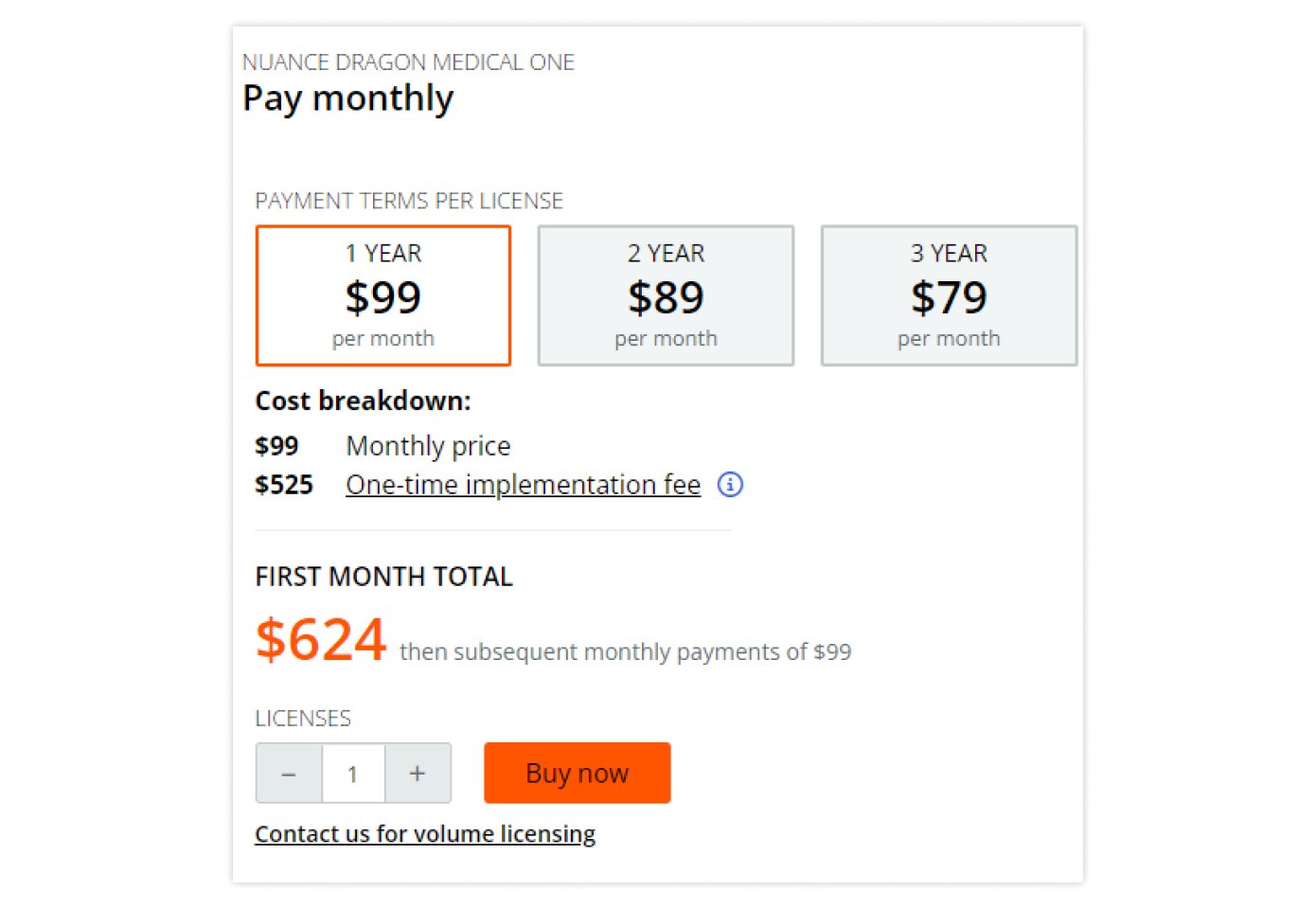
Nuance offers two types of payment for its software: monthly and prepayment.
If you pay monthly, the software will cost $99 (for a 1-year licence). On top of that, you need to pay an on-time implementation fee of $525. It includes:
- A one-on-one session with a certified expert to help you install and use the software.
- Workflow consulting during the licence period.
- Q&A sessions with Dragon Medical trainers.
Medesk helps automate scheduling and record-keeping, allowing you to recreate an individual approach to each patient, providing them with maximum attention.
Learn more >>#2. Deepgram Medical Speech to Text API
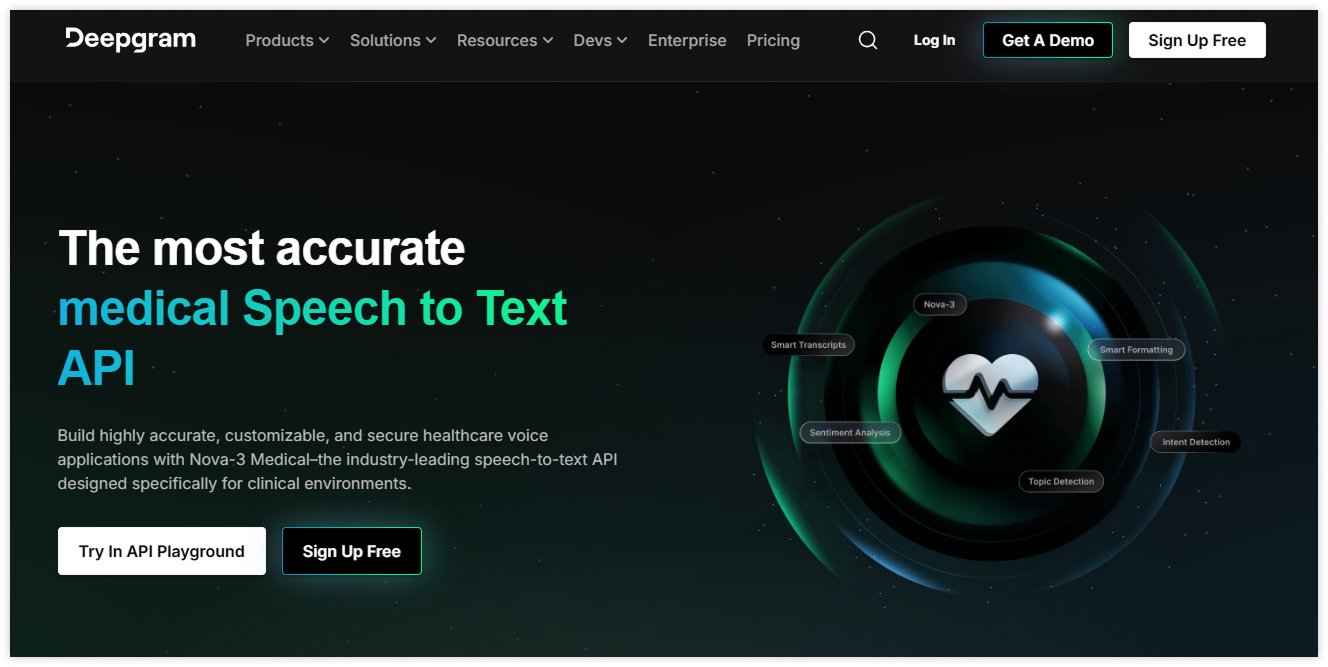
Deepgram offers an advanced speech-to-text API powered by deep learning and AI. The It’s a strong choice for clinics and hospitals, or anyone that needs to connect health applications.
Key Features
Medical-grade accuracy. Deepgram’s Nova-3 Medical Model has been trained to understand complicated medical terminologies, medications, symptoms and diagnoses.
Smart formatting tools. The software punctuates, paragraphs and autoexpands abbreviations and acronyms for easy-to-read notes.
Speaker identification. Today, it is easy to differentiate who is speaking in a recording. It’s a helpful feature for doctor-patient or multi-speaker calls.
Multi-language support. It supports multiple languages and accents and can be beneficial for teams working with a wide variety of patients.
Flexible API integration. Deepgram integrates well with EHR and other medical software.
Pros
- Very accurate for medical language and jargon.
- Fast transcription with low latency.
- HIPAA-compliant and secure.
- Free credits for new users.
- Easy API integration.
Cons
- May be expensive with smaller practices.
- Some technical work is required for full integration.
- Limited offline functionality.
Pricing
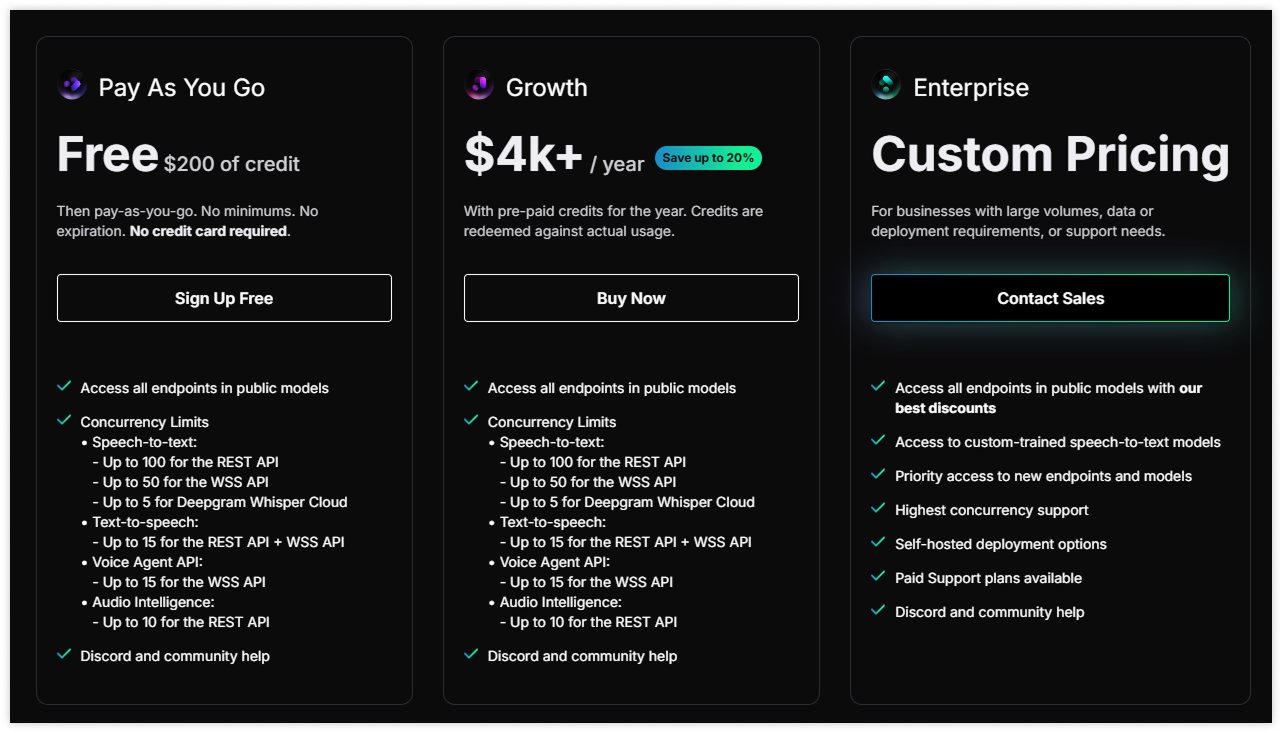
You can try Deepgram for free with $200 in credits (about 45,000 minutes of transcription).
Paid plans include:
- Growth Plan: $4,000–$10,000 per year: includes access to 100 concurrent Deepgram model requests and 5 for Whisper Cloud.
- Enterprise Plan: Custom pricing with full access to Deepgram’s products and dedicated support.
#3. DeepScribe: AI-Powered Medical Transcription Made Easy
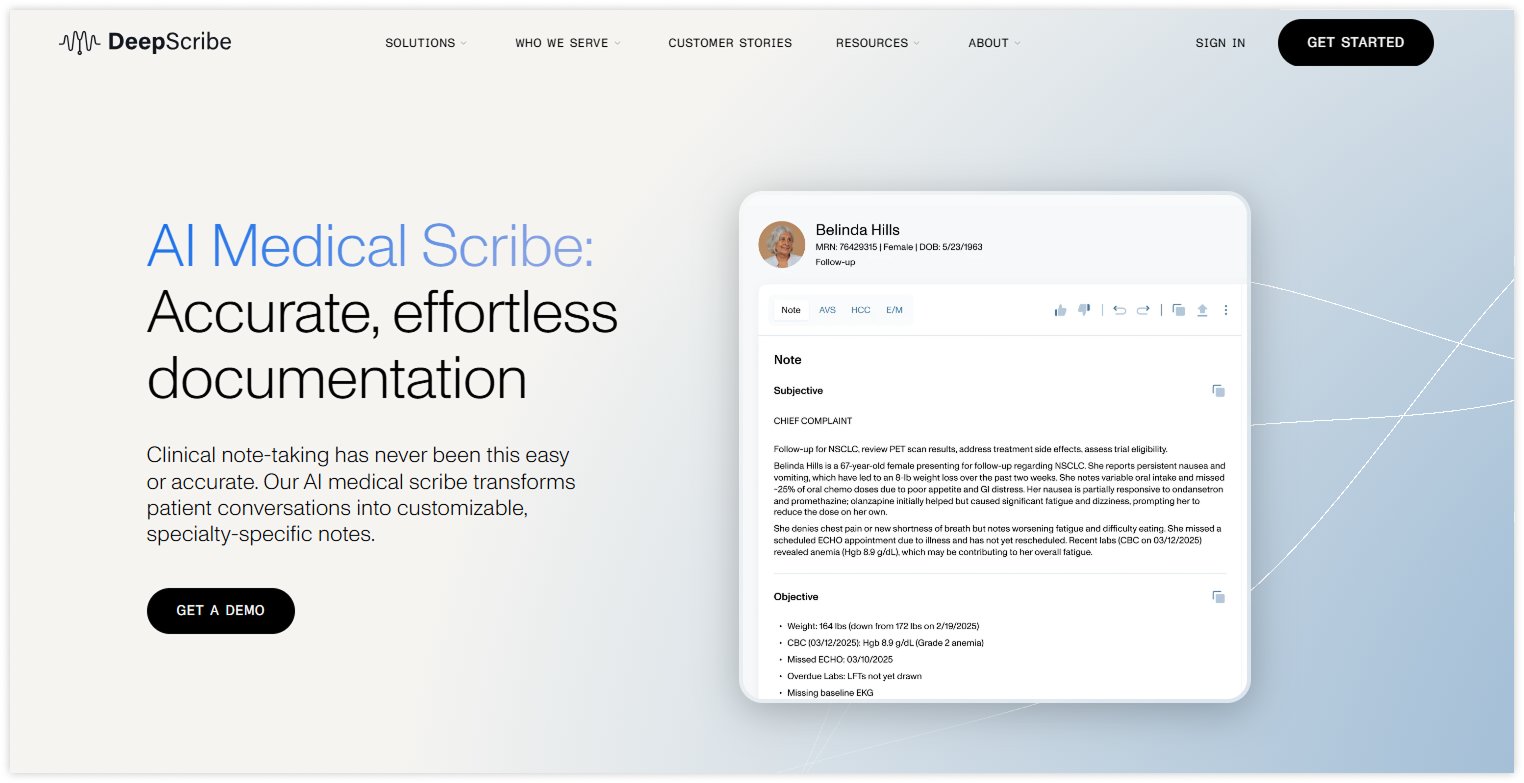
DeepScribe is medical transcription software that uses artificial intelligence and natural language processing to automate clinical documentation. In real time, it listens to doctor-patient conversations and correctly turns them into structured medical notes, allowing physicians to save time.
If your healthcare organisation wishes to construct additional NLP- or machine learning-powered tools unique to your workflow, using a company’s AI software development services will allow you to introduce them to the market quickly to better capture value.
Key Features
Real-time speech recognition. Captures patient conversations as they happen.
Automatic EHR integration. Notes are synced directly into electronic health records.
Specialty-specific customisation. You can tailor the templates for different medical specialties and workflows.
AI coding support. Generate accurate ICD-10 and other billing codes.
Pre-charting. Pulls relevant data from past visits to give context for upcoming appointments.
HIPAA compliant and multilingual. Supports secure patient data handling and over 25 languages.
Pros
- Saves significant time on documentation and charting.
- Reduces errors and improves note accuracy.
- Adapts to each provider’s style and specialty workflow.
- Improves coding accuracy and supports proper billing.
- Works across in-person and telehealth settings.
Cons
- Currently available only for healthcare providers in the USA.
- Mistakes can happen when multiple people are talking at once.
Pricing
The price of the software is flexible and highly individual, depending on the size of the clinic, specialisation, need of EHR integration, etc. For a price estimate, contact the sales team directly.
Discover more about the essential features of Medesk and claim your free access today!
Explore now >>#4. Amazon Transcribe Medical
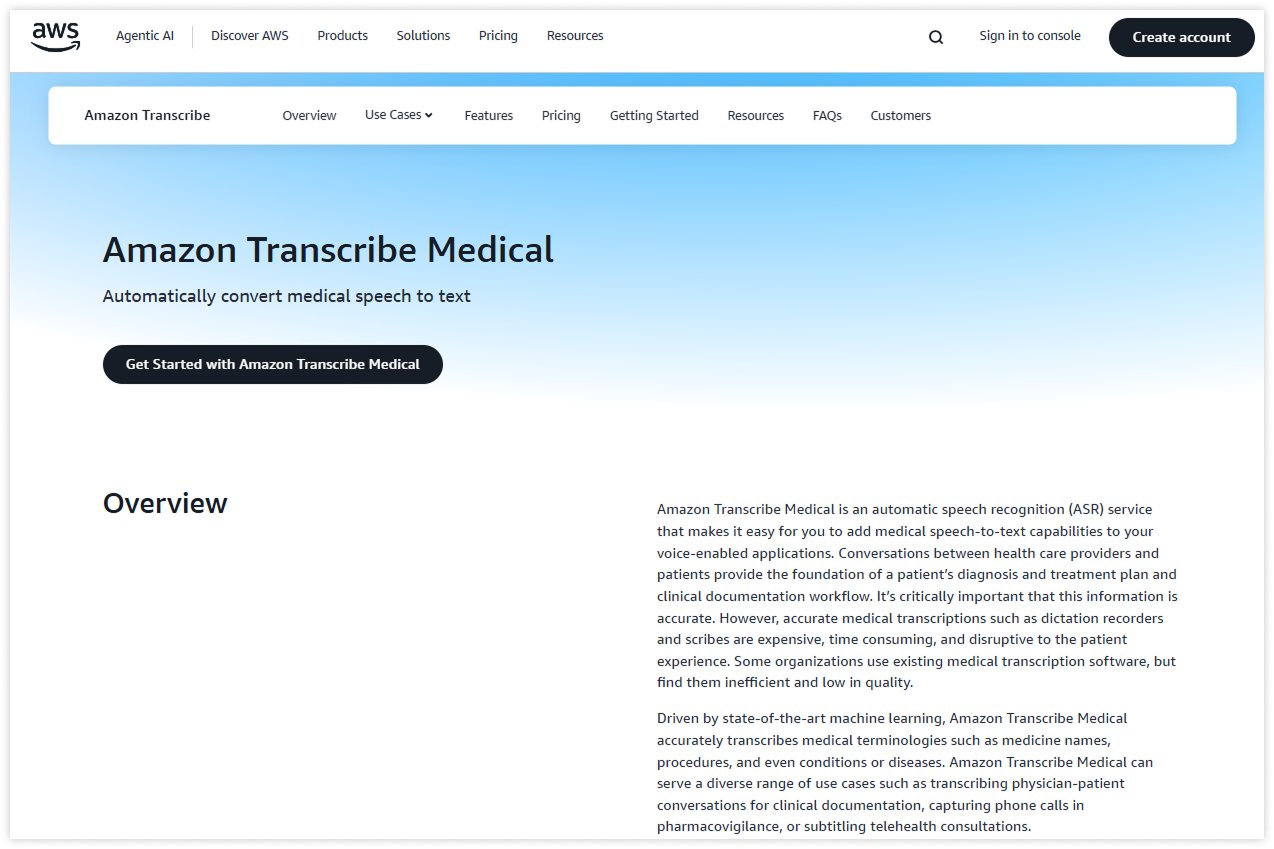
Amazon Transcribe Medical is a machine learning automatic speech recognition (ASR) service that makes it easy for developers, even those with no prior machine learning experience, to add speech-to-text capability to their applications.
It assists doctors and nurses by rendering spoken conversations into correct, readable text, improving the speed and reliability with which clinical notes can be recorded.
Key Features
Medical accuracy. It’s been trained on a massive corpus of medical speech and does very well at identification of medical terms, drugs, procedures and diagnoses.
Specialty customisation. Supports specific fields such as cardiology, neurology, paediatrics, oncology, radiology and adaptive features that learn from voice with higher accurate transcriptions.
Real-time and batch processing. Good for live dictation or turning pre-recorded audio into text.
API access. The service can be embedded into apps whereby developers will tend to use the service for automation purposes.
Pros
- Highly accurate medical transcription
- Supports multiple specialties
- HIPAA-compliant, secure, and reliable
- API-driven adoption, friendly to integration with apps and EHR systems
- Pay-as-you-go pricing, with a free tier available for testing.
Cons
- Costs could mount with heavy use
- Requires some integration work with APIs to set up tech properly
- Not the best for small practices that want a plug-and-play transcription tool
Pricing
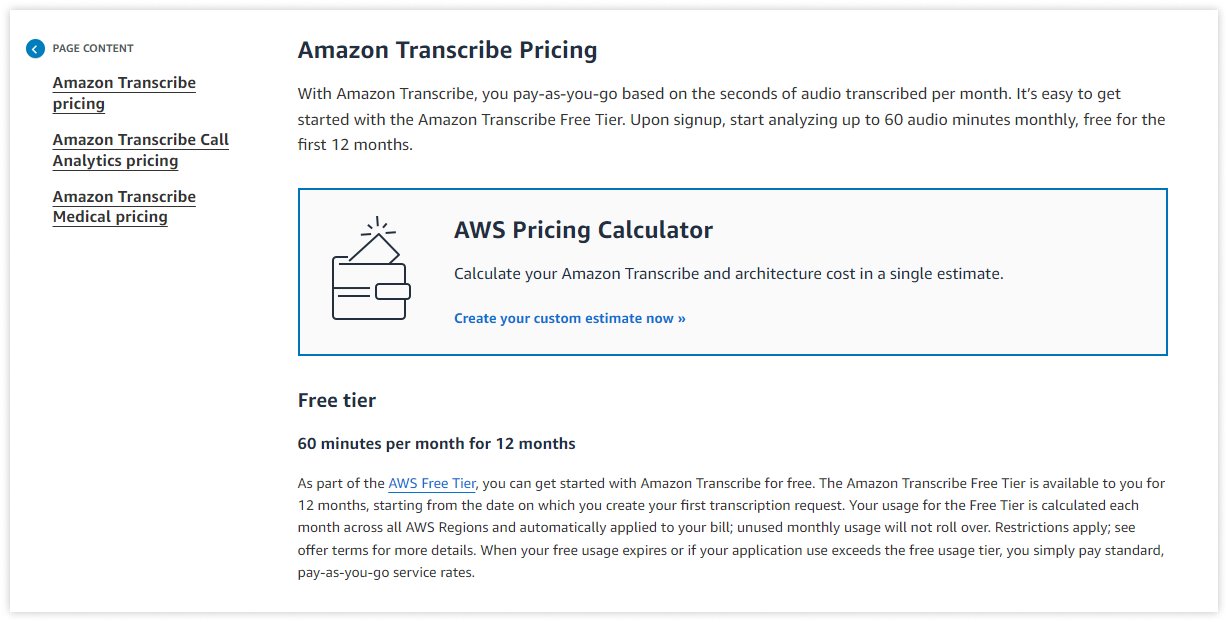
Amazon Transcribe Medical uses a pay-as-you-go model: you pay only for the seconds of audio you transcribe.
A free tier allows up to 60 minutes of transcription per month. For more precise details, you can use the AWS Pricing Calculator for estimating your overall AWS service costs or contact AWS Sales for a custom quote.
#5. WebChartMD: Scalable Dictation for Hospitals and Clinics

WebChartMD is a web-based dictation platform that caters to the needs of physicians, hospitals, transcription companies and surgery centres.
Key Features
Flexible dictation options. Record by phone, computer, mobile app, digital recorder or SpeechMike, or upload a file.
Transcription and quality control. Transcribe audio, edit reports and combine internal staff or external transcriptionists into one workflow.
Document review and e-signature. Transcriptionists and physicians have the ability to e-sign the documents electronically for enhanced safety and expediency.
Integration capabilities. API available Integrate with EHRs and other healthcare software.
Pros
- Compatible on mobile and desktop.
- Supports multiple perspectives of dictations.
- Flexible to needs in specialties and workflows.
- Suitable for single doctors, large hospitals, and transcription companies.
Cons
- Pricing is not mentioned, and it could be necessary to contact the sales team.
- A bit of a learning curve for some users, with it being very feature-rich.
Pricing
WebChartMD has a free trial with a $500 credit toward your first month. Pricing is personalised according to the size of a practice and certain elements.
How to Choose the Right Medical Dictation Tool
Which of these is the best solution for you depends on what you're trying to accomplish. Below is a rundown to help you make up your mind:
- We recommend Nuance Dragon Medical or DeepScribe for reliable features, deep EHR integration, and industry-best accuracy.
- If budget is a consideration and if you need customisation for your domain, Deepgram or Amazon Transcribe Medical might be suitable with their on-demand pay-as-you-go billing.
- For practices with a need for workflow management tools and the ability to scale for a very high number of transcriptions, WebChartMD might be the right solution.
If you work with non-English-speaking patients, dictation software handles your voice-to-text needs, but you'll still need medical translation services for patient-facing documents. Consent forms, discharge summaries, and treatment instructions require accurate language conversion that maintains clinical precision, something separate from the dictation process itself.
Medical Dictation Software FAQs
1. How do I choose medical dictation software?
Consider accuracy, ease of use, HIPAA compliance, integration with EHRs, mobile access and AI help. Customisable templates and secure e-signatures are great benefits.
2. What’s the difference between medical dictation and voice recognition software?
Medical dictation understands medical terms, templates and compliance standards. Typical voice tools don’t, and so can misunderstand clinical language and are not HIPAA-safe.
3. Do I need special equipment?
Not really. Most software is designed to run on computers, tablets or phones. A quality headset or digital recorder may improve audio, though it isn’t necessary.
4. Can I integrate transcription with my EHR and practice management software?
Yes. The majority of platforms integrate directly with EHRs and PM systems, so your patient records are automatically up-to-date.
5. How accurate is medical dictation software?
Top-tier systems like DeepScribe hit 95–99% accuracy. The accuracy is even better when combined with human review.
6. Can I use medical dictation software for multi-location practices?
Definitely. Cloud-based solutions make it easy for your workforce to share dictations, monitor workflow and gauge productivity regardless of location.
7. Are there medical transcription apps for mobile?
Yes. Some solutions have iOS and Android apps, allowing you to dictate and review notes on your mobile device.


